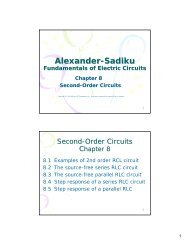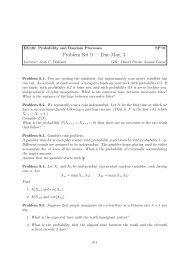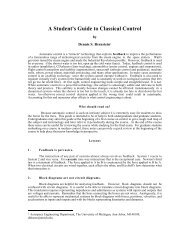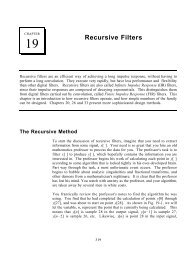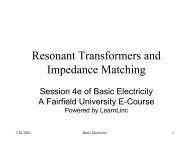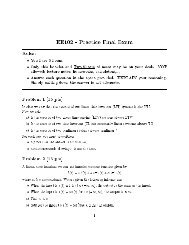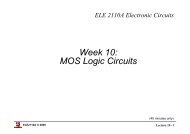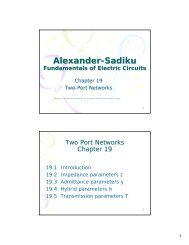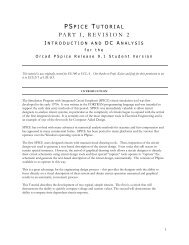Chapter 15 Alternating Current
Chapter 15 Alternating Current
Chapter 15 Alternating Current
You also want an ePaper? Increase the reach of your titles
YUMPU automatically turns print PDFs into web optimized ePapers that Google loves.
<strong>Chapter</strong> <strong>15</strong><br />
AC Fundamentals<br />
<strong>Alternating</strong> <strong>Current</strong><br />
Voltages of ac sources alternate in<br />
polarity and vary in magnitude<br />
Voltages produce currents that vary in<br />
magnitude and alternate in direction<br />
2<br />
1
<strong>Alternating</strong> <strong>Current</strong><br />
A sinusoidal ac waveform starts at zero<br />
Increases to a positive maximum<br />
Decreases to zero<br />
Changes polarity<br />
Increases to a negative maximum<br />
Returns to zero<br />
Variation is called a cycle<br />
3<br />
Generating AC Voltages<br />
4<br />
2
Generating AC Voltages<br />
5<br />
AC Voltage-<strong>Current</strong> Conventions<br />
Assign a reference polarity for source<br />
When voltage has a positive value<br />
Its polarity is same as reference polarity<br />
When voltage is negative<br />
Its polarity is opposite that of the reference<br />
polarity<br />
6<br />
3
AC Voltage-<strong>Current</strong> Conventions<br />
Assign a reference direction for current<br />
that leaves source at positive reference<br />
polarity<br />
When current has a positive value<br />
Its actual direction is same as current<br />
reference arrow<br />
7<br />
AC Voltage-<strong>Current</strong> Conventions<br />
When current is negative<br />
Its actual direction is opposite that of current<br />
reference arrow<br />
8<br />
4
Frequency<br />
Number of cycles per second of a<br />
waveform<br />
Frequency<br />
Denoted by f<br />
Unit of frequency is hertz (Hz)<br />
1 Hz = 1 cycle per second<br />
9<br />
Period<br />
Period of a waveform<br />
Time it takes to complete one cycle<br />
Time is measured in seconds<br />
The period is the reciprocal of frequency<br />
T = 1/f<br />
10<br />
5
Amplitude and Peak-to-Peak Value<br />
Amplitude of a sine wave<br />
Distance from its average to its peak<br />
We use E m for amplitude<br />
Peak-to-peak voltage<br />
Measured between minimum and maximum<br />
peaks<br />
11<br />
We use E pp or V pp<br />
Peak Value<br />
Peak value of an ac voltage or current<br />
Maximum value with respect to zero<br />
If a sine wave is superimposed on a dc<br />
value<br />
Peak value of combined wave is sum of dc<br />
voltage and peak value of ac waveform<br />
amplitude<br />
12<br />
6
The Basic Sine Wave Equation<br />
Voltage produced by a generator is<br />
e = E m sin<br />
E m is maximum (peak) voltage<br />
is instantaneous angular position of<br />
rotating coil of the generator<br />
13<br />
The Basic Sine Wave Equation<br />
Voltage at angular position of sine wave<br />
generator<br />
May be found by multiplying E m times the sine<br />
of angle at that position<br />
14<br />
7
Angular Velocity<br />
Rate at which the generator coil rotates<br />
with respect to time, (Greek letter<br />
omega)<br />
<strong>15</strong><br />
Angular Velocity<br />
Units for are revolutions/second,<br />
degrees/sec, or radians/sec.<br />
t<br />
t<br />
16<br />
8
Radian Measure<br />
is usually expressed in radians/second<br />
2 radians = 360°<br />
To convert from degrees to radians,<br />
multiply by /180<br />
17<br />
Radian Measure<br />
To convert from radians to degrees,<br />
multiply by 180/<br />
When using a calculator<br />
Be sure it is set to radian mode when working<br />
with angles measured in radians<br />
18<br />
9
Relationship between ,T, and f<br />
One cycle of a sine wave may be<br />
represented by = 2 rads or t = T sec<br />
T<br />
t<br />
2<br />
2<br />
T<br />
2 f<br />
19<br />
Voltages and <strong>Current</strong>s as<br />
Functions of Time<br />
Since = t, the equation e = E m sin<br />
becomes e(t) = E m sin t<br />
Also, v(t) = V m sin t and i(t) = I m sin t<br />
20<br />
10
Voltages and <strong>Current</strong>s as<br />
Functions of Time<br />
Equations used to compute voltages and<br />
currents at any instant of time<br />
Referred to as instantaneous voltage or<br />
current<br />
21<br />
Voltages and <strong>Current</strong>s with<br />
Phase Shifts<br />
If a sine wave does not pass through zero<br />
at t = 0, it has a phase shift<br />
For a waveform shifted left<br />
v = V m sin( t + )<br />
For a waveform shifted right<br />
v = V m sin( t - )<br />
22<br />
11
Phasors<br />
Rotating vectors whose projection onto a<br />
vertical or horizontal axis can be used to<br />
represent sinusoidally varying quantities<br />
23<br />
Phasors<br />
A sinusoidal waveform<br />
Produced by plotting vertical projection of a<br />
phasor that rotates in the counterclockwise<br />
direction at a constant angular velocity<br />
24<br />
12
Phasors<br />
Phasors apply only to sinusoidally<br />
varying waveforms<br />
25<br />
Shifted Sine<br />
Waves<br />
Phasors used to<br />
represent shifted<br />
waveforms<br />
Angle is position<br />
of phasor at t = 0<br />
seconds<br />
26<br />
13
Phase Difference<br />
Phase difference is angular displacement<br />
between waveforms of same frequency<br />
If angular displacement is 0°<br />
Waveforms are in phase<br />
27<br />
Phase Difference<br />
If angular displacement is not 0 o , they are<br />
out of phase by amount of displacement<br />
28<br />
14
Phase Difference<br />
If v 1 = 5 sin(100t) and v 2 = 3 sin(100t -<br />
30° ), v 1 leads v 2 by 30°<br />
May be determined by drawing two waves<br />
as phasors<br />
Look to see which one is ahead of the other<br />
as they rotate in a counterclockwise direction<br />
29<br />
Average Value<br />
To find an average value of a waveform<br />
Divide area under waveform by length of its<br />
base<br />
Areas above axis are positive, areas<br />
below axis are negative<br />
30<br />
<strong>15</strong>
Average Value<br />
Average values also called dc values<br />
dc meters indicate average values rather than<br />
instantaneous values<br />
31<br />
Sine Wave Averages<br />
Average value of a sine wave over a<br />
complete cycle is zero<br />
Average over a half cycle is not zero<br />
32<br />
16
Sine Wave Averages<br />
Rectified full-wave average is 0.637 times<br />
the maximum value<br />
Rectified half-wave average is 0.318 times<br />
the maximum value<br />
33<br />
Effective Values<br />
Effective value or RMS value of an ac<br />
waveform is an equivalent dc value<br />
It tells how many volts or amps of dc that an ac<br />
waveform supplies in terms of its ability to<br />
produce the same average power<br />
34<br />
17
Effective Values<br />
In North America, house voltage is 120<br />
Vac.<br />
Voltage is capable of producing the same<br />
average power as a 120 V battery<br />
35<br />
Effective Values<br />
To determine effective power<br />
Set Power(dc) = Power(ac)<br />
P dc = p ac<br />
I 2 R = i 2 R where i = I m sin t<br />
By applying a trigonometric identity<br />
Able to solve for I in terms of I m<br />
36<br />
18
I eff = .707I m<br />
Effective Values<br />
V eff = .707V m<br />
Effective value is also known as the RMS<br />
value<br />
37<br />
19
This document was created with Win2PDF available at http://www.daneprairie.com.<br />
The unregistered version of Win2PDF is for evaluation or non-commercial use only.





